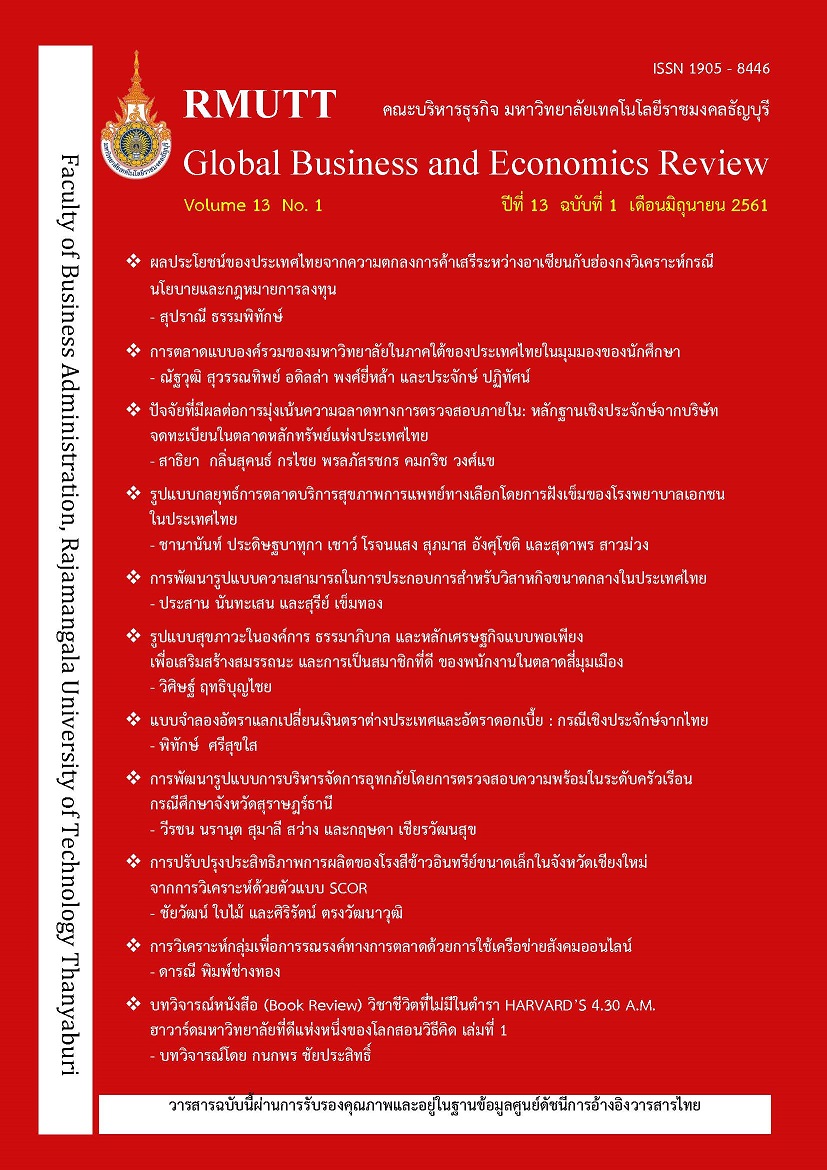EXCHANGE RATE MODEL AND INTEREST RATE EVIDENCE FROM THAILAND
Keywords:
Exchange Rate Model, Interest Rate Parity Condition, Cointegration Relationship, ARIMA ModelAbstract
This research is to explore the relationship between the interest rate difference of Thailand and the United States and exchange rate in Baht and US dollar. The finding shows that such comovement is not consistent with uncovered interest rate parity. Additionally, the exchange rate model demonstrates that money supply of home country at time t , foreign price level at time t, foreign interest rate in the next period, and real output of home country at time t determine the current exchange rate. Moreover, the result indicates that the uncovered interest parity condition is violated. That is, it cannot capture the exchange rate movement. The multiple linear regression model reveals that the Thai broad money supply has a positive impact on exchange rate. On the contrary, the US consumer price index is negatively related to its exchange rate. In particular, such model clearly outperforms the other models. In addition, there are two cointegrating relationships. VECM explains that if there is a deviation from the long-run relationship, the exchange rate will suddenly move toward the equilibrium again with speed of adjustment of 2.219%. Such model is not appropriate for exchange rate forecasting. In contrast, ARIMA (1, 1, 1) model is more effective than the other one. Consequently, the Bank of Thailand should not focus solely on the interest rate difference between Thailand and the United States. Instead, they should not only concentrate on broad money supply of Thailand, but also pay attention to the movement of consumer price index in the United States. This is because both of them significantly affect on the Thai exchange rate.
References
Engle, R. F. (1996). The Econometrics of Ultra-High Frequency Data. University of California at San Diego Economics Working Paper Series, 96-15.
Fama, E. F. (1984). Forward and spot exchange rates. Journal of Monetary Economics, 14, 319- 338.
Frenkel, J. A. (1976). A monetary approach to the exchange rate: Doctrinal aspects and empirical evidence. Scandinavian Journal of Economics, 78(May), 200-224.
Froot, K. and Thaler, R. (1990). Anomalies: Foreign Exchange. Journal of Economic Perspectives, 4, 2, 89-92.
Hodrick, R. J. (1987). The Empirical Evidence on the Efficiency of Forward and Futures Foreign Exchange Markets, Harwood, London.
Isard, P. (2006). Uncovered interest parity. IMF Working Paper, WP/06/96.
Lothian, J.R., Wu. L. (2011). Uncoverd interest-rate parity over the past two centuries. Journal of International Money and Finance, 30, 448-473.
Macdonald, R., M.P. Taylor. (1992). Exchange Rate Economics. A Survey. International Monetary Fund Staff Paper, 39, (1), 1-57.
McCallum, B. (1994). A reconsideration of the uncovered interest parity condition. Journal of Monetary Economics, 33, 105-132.
Meese, R.A., Rogoff, K. (1983). Empirical exchange rate models of the seventies: Do they fit Out of sample? Journal of International Economics, 14, 3-24.
Mussa, M. (1967). The exchange rate, the balance of payment, and monetary and fiscal policy under a regime of controlling floating. Scandinavian Journal of Economics, 78 (May), 229-248.
Pongsaparn, R. (2007). Inflation targeting in a small open economy: a challenge to monetary theory.” Bank of Thailand Discussion Paper.
Downloads
Published
How to Cite
Issue
Section
License
The articles published in this journal are the intellectual property of their respective authors.
The views and opinions expressed in each article are solely those of the individual authors and do not reflect the positions of Rajamangala University of Technology Thanyaburi or any of its faculty members. All components and content of each article are the sole responsibility of the respective authors. In the event of any errors, the authors shall bear full responsibility for their own work.








